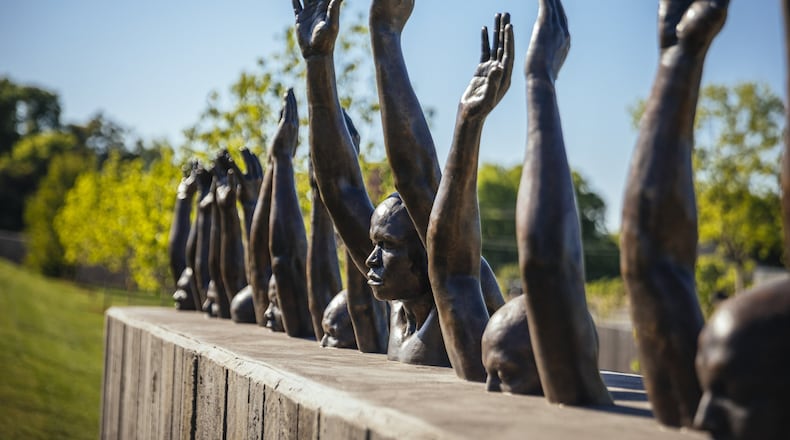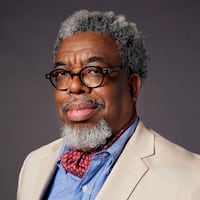The lynching memorial that opened last week in Montgomery has exposed anew the barbarism and savagery of white supremacy in the post-Civil War South.
The memorial lists thousands of people across the country, many of them tortured, all of them murdered, for any reason the white mob could devise — or for no reason at all. The documented tally in Georgia was 637. Some in Georgia today don’t know about these crimes. Some can’t forget about them. But from the time of Reconstruction until well into the 20th century, these horrors were and remain part of our story.
A database maintained by the Tuskegee Institute offers a spare record of unimaginable carnage in Georgia: six men lynched for arson in April 1899 in Palmetto. Three months later, eight men lynched in Early County, all accused of "rape and robbery." In 1892, a man lynched in Dalton because he "voted Democratic."
» Investigating my family's role in 4 lynchings
The National Memorial for Peace and Justice in Montgomery commemorates the deaths of these and 5,000 other people taken by mobs that hanged, shot or burned their victims to death. Sometimes they did all three.
So Mary Turner knew she was about to die.
It was May 19, 1918, almost exactly 100 years ago. The lynch mob in Brooks County had already tortured and killed eight black men in two days — retaliation for the shooting death of a white planter.
Turner’s husband, Hayes, was one of the dead. What happened to him, and what would happen to Mary, reflected the brutal social order of the day.
“The foundation of the South was white supremacy,” said E.M. Beck, a retired sociologist at the University of Georgia and the co-author of “A Festival of Violence: An Analysis of Southern Lynchings 1882-1930.” “And when you start getting challenges to social and economic order, then you start (moving toward) things that support the old order. Black folks weren’t seen as part of the community. They were seen as necessary ‘foreign’ labor. The white folks were ‘the community.’ When those boundaries began to break down, then you begin to see this violence.”
As the mob carried Mary Turner to the Little River, which serves as the border of Brooks and Lowndes counties, they took her past the tree where they’d mutilated and then hanged her husband. His body was still suspended there. Near the Folsom Bridge, they hung Mary Turner upside down by her ankles across the sturdy limb of an oak tree, doused her body with gasoline and burned her clothes off.
That was just the beginning.
“This is one of the more heinous and brutal ones in terms of butchering people,” said Mark Patrick George, a former Valdosta State University sociology professor who helped raise money for a memorial marker for Turner near the site of her killing. “But that wasn’t that uncommon.”
Mary Turner’s “crime?”
Arguing that her husband was not involved in the murder, having the audacity to complain about his lynching and saying that she would report the names of the men who killed him. Or as the media reported it at the time, making “unwise remarks.”
The first recorded lynching in Georgia was in 1880 in Clayton County. There was no known reason for the death of Milly Thompson, and it is unclear whether Thompson was male or female. The last recorded lynching was David Jackson, who was killed in McDuffie County in 1961. The reason for his death is also unknown.
Some only went by one name. Nux. Oglesby. McFadgen. The names of 66 aren’t known at all. Of the 637 people lynched in Georgia, 257 died within a 19-year period during America’s Gilded Age between 1880 and 1899.Of those lynched, 17 were women, including Mary Turner and one white woman accused of murder in 1884.
‘Every time, chills go through me’
The psychological impact of those killings continues to affect families even a century later.
On the rare occasions that Charles T. Forehand visited his family in Brooks County he would stay with his great-grandmother, the younger sister of Hayes Turner.
She told stories of how part of his bloodline was exterminated in the woods 100 years ago.
“It was spoken of in hushed whispers,” said Forehand, 63, who was born and raised in Miami. “They would talk, but I would have to pry. It was emotionally painful for them to talk about. Today, every time this topic comes up, chills go through me.”
Lavon Gant, whose grandfather was Mary Turner’s brother, lived a different experience. She moved to New Jersey when she was 3 but would often visit the area as a child. Her mother made sure she knew every detail of the lynching.
“We were always inquistive about race relations and our family,” said Gant, 70. “What my mother told me always stayed with me because it was so horrific and I could not believe that something like that could happen. It was so horrific. It has never left me what they did to her.”
‘Bore a very poor reputation’
Hampton Smith was the brutal boss of the Old Joyce Plantation who, according to NAACP secretary Walter White “bore a very poor reputation in the community because of ill treatment to his Negro employees.”
When he couldn’t find enough workers, he would pay for convict labor, a forced-labor scheme detailed by Douglas A. Blackmon in his Pulitzer Prize-winning book “Slavery By Another Name: The Re-enslavement of Black Americans from the Civil War to World War II.” One of the men Hampton Smith paid for was Sidney Johnson, who had been convicted of shooting dice.
After one too many beatings, Johnson shot and killed the 25-year-old Smith. He fled to Valdosta. As was the custom, a large mob gathered. The men intended to track Johnson down but wound up slaughtering at least five black men — perhaps as many as 10 — before they found Johnson..
On May 17, they captured and killed Will Head, Will Thompson and Julius Jones.
On May 18, they killed Eugene Rice near the Old Camp Ground, although it was acknowledged that he knew nothing about the murder. They also arrested Mary Turner’s husband, Hazel “Hayes” Turner, in Valdosta because he had threatened Smith earlier for beating Mary.
As deputies transported him from Valdosta to Brooks County, a mob seized Turner and lynched him near the Okapiloo River. They left his body hanging from a tree all weekend.
It is unclear when the three unidentified bodies found in the Little River were placed there. Or when Chime Riley, who was found in the Little River with turpentine cups tied to his hands and legs, was killed. Or whatever happened to Simon Schuman, who was never seen again.
The ‘spectacle lynching’ of Mary Turner
But on May 19, the killing continued with Mary Turner.
As Walter White, who investigated the killings for the NAACP wrote, “The method by which Mary Turner was put to death was so revolting and the details are so horrible that it is with reluctance that the account be given.”
Estimates of Mary Turner’s age ranged from 19 to 33-years-old.
No one knows for sure whether she was still alive after the mob burned her clothes off, but that hardly mattered. Neither did it matter that Mary Turner was eight months pregnant. As her body hung from the tree, someone took a knife, “such as one used in splitting hogs,” and split Mary Turner’s abdomen open. Her baby fell to the ground and cried.
A member of the mob crushed the baby’s head. Others in the mob shot Mary Turner’s body hundreds of times.
The brutality of Turner’s murder has haunted Carol Anderson, author of the National Book Critics Circle Award winning book “White Rage: The Unspoken Truth of Our Racial Divide.” Anderson said killings such as that of Turner were not simply a satisfaction of blood lust but were intended to send a message.
“Lynching is about black people not knowing their ‘place,’ which is subordinate to whites,” Anderson said. “In spectacle lynchings, it was about sending a signal to the black community about knowing their place and putting them there. To say, ‘This is what we’ll do to you if you get out of place and there’s no power that will come to your rescue.’”
On May 22 Sidney Johnson, who had killed Hampton Smith, was discovered holed up in a house in Valdosta. He died in a shootout with the police, but a mob still stormed the house. They mutilated Johnson’s body, put a rope around his neck and used a car to drag the corpse down the busiest street in town. They finally tied what was left of the body to a tree and burned it.
In all 13 people had died in perhaps the largest instance of mob violence in Georgia.
‘It has five bullet holes in it’
Mark Patrick George, now a college teacher in Oregon, grew up in Valdosta. He used to fish and canoe in the Little River, but he had not heard about the lynchings and Mary Turner until 2006.
“They killed her where I put in my canoe. How did we not know about this? It was submerged and buried, at least in the white community,” George said. “I am still speechless about the capacity of folks from where I am from to have done this. My grandmother was 18 when this happened and my grandfather was in his 20s. I would not have been surprised if he had been there.”
Charles T. Forehand’s branch of the Turner family fled the area — although many family members stayed — but he would visit the area on occasion. On one stop, he ventured alone into the woods where Mary Turner and his distant baby cousin were killed.
“I started taking pictures — of the area and there was a definite silence. No birds. No crickets. Nothing,” said Forehand, adding that the experience had shaken him. “When I got back to my car it was almost as if I was having an out of body experience.”
In 2012, through the Mary Turner Project, George, along with volunteers from Valdosta State and descendants of Turner’s family, paid for and erected a memorial a few yards from where she died. On a hot, muggy May afternoon, George and three other members of the project, had to place the memorial themselves and used water from the Little River to mix the concrete.
On the upcoming centennial anniversary of her death, May 19, the Mary Turner Project will bring together members of the community and her family to the site of Mary Turner's death to commemorate her life.
In preparation for the event, George got a call recently from a state official asking him whether he wanted to replace the memorial. Someone had shot it up.
“I told them no. It has five bullet holes in it and those bullet holes were put there by someone who this sign doesn’t matter to. Just like Mary Turner’s life didn’t matter,” George said. “That marker is a physical artifact that people have to confront.”
The Latest
Featured









